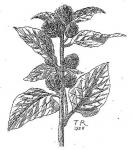Great burdock.
 (Arctium lappa).
(Arctium lappa).
Also see Hool, 1918: Burdock.
Arctium—From the Greek arktos, a bear (arth, Celtic), on account of the rough, bristly fruit, which may be compared to the coarse hair of a bear, and Lappa derived from the Celtic llap, "a hand," because it lays hold of everything near it. The Burdock is too familiar to every schoolboy to need illustration. It is equally common in Europe and Japan, by roadsides and on ditch banks. Few quadrupeds, except the ass, will eat the plant, but birds feed on the seeds, and snails and caterpillars on the leaves. The stems, stripped of their rind before the flowers appear, may be eaten, either boiled or raw, with oil and vinegar. Withering says: "A decoction of the roots is esteemed by some equal to that of sarsaparilla." Burnt, when green (= fresh), between the time of flowering and seeding, three pounds of the ashes produced 16 ozs. of a very white alkaline salt as good as the best potash. The leaves and stems are bitter, and act very well as a tonic and stomachic. The root and seeds are of a sweetish taste, and are a splendid purifier of the blood, and a cleanser of all skin diseases; and in affection of the kidneys, such as atrophy or wasting away. Its equal cannot be found in all the Materia Medica.
Common Plants and their Uses in Medicine was written by Richard Lawrence Hool, F.N.A.M.H., in 1922.

